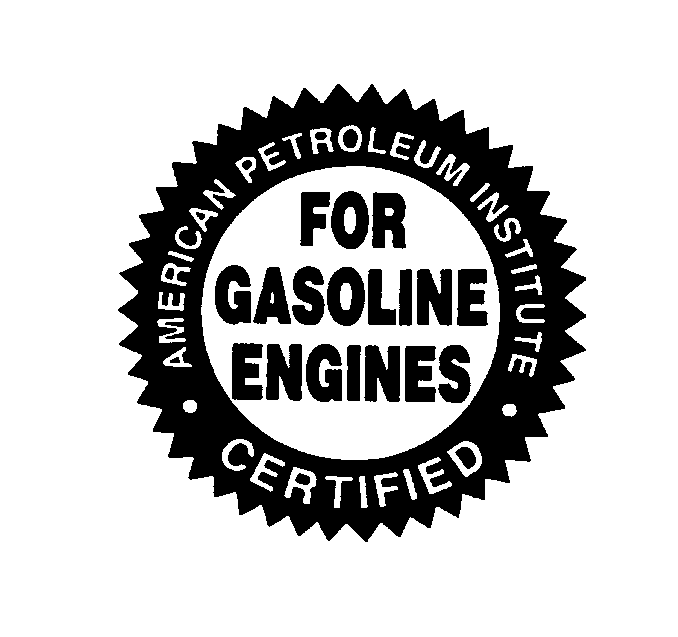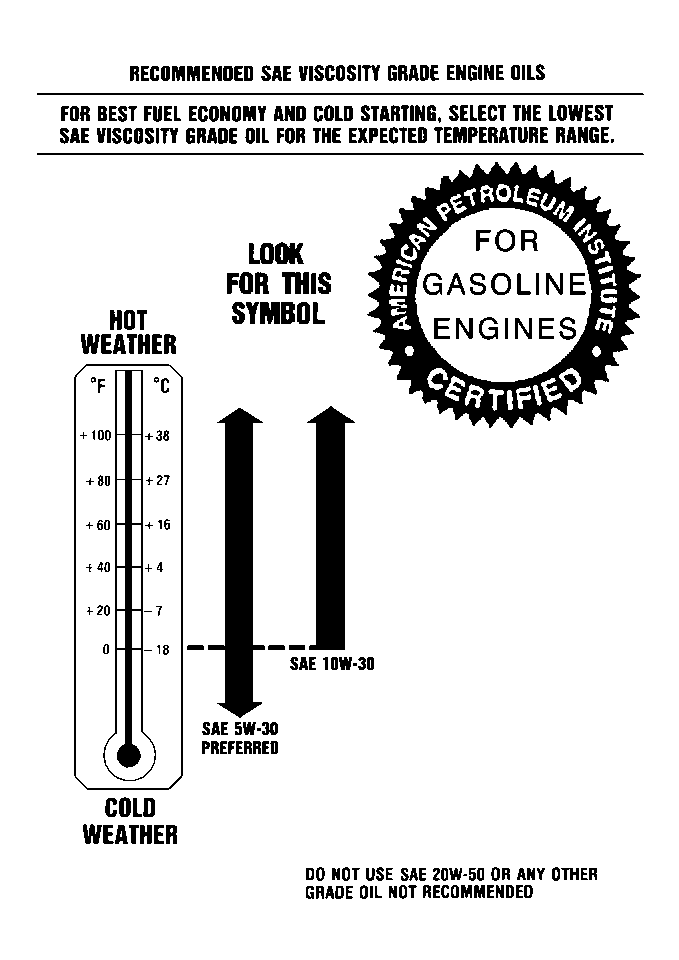For time and/or mileage intervals of scheduled maintenance items, refer to Maintenance Schedule .
The following text and illustrations describe the details of the required scheduled maintenance services.
For information on the proper fluids and lubricants to use, refer to Fluid and Lubricant Recommendations .
Engine Oil and Filter Change
Change both the engine oil and the filter according to the maintenance schedule intervals. For the engine oil and filter changing procedure, refer to Engine Oil and Oil Filter Replacement in Engine Mechanical -1.8L (LV6) or Engine Oil and Oil Filter Replacement in Engine Mechanical - 1.8L (LNK).
For information on the correct engine oil quality and viscosity, refer to the following:
Engine Oil Quality

Notice: Use only engine oil with the American Petroleum Institute Certified for Gasoline Engines starburst symbol. Failure to use the recommended oil can result in engine damage not covered by the warranty.
The STARBURST symbol indicates that the oil has been certified by the American Petroleum Institute (API). Do not use any oil which does not carry the STARBURST symbol.
Engine Oil Viscosity

Notice: Using oils of any viscosity other than those recommended could result in engine damage. When choosing an oil, consider the range of temperatures the vehicle will be operated in before the next oil change. Then, select the recommended oil viscosity.
The recommended oil viscosity for this vehicle is 5W-30.
Engine oil viscosity (thickness) has an effect on the fuel economy and the cold-weather operation (starting and oil flow). Lower viscosity engine oils can provide better fuel economy and cold-weather performance. However, higher temperature weather condition require higher viscosity engine oils for satisfactory lubrication. When the temperature is consistently above -18°C (0°F), SAE 10W-30 can be used. SAE 20W-50 or oils of other viscosity rating or quality designations are NOT recommended for use in this vehicle at any time.
Chassis Lubrication
Notice: Do not lubricate the parking brake cables. Lubrication destroys the plastic coating on the cable.
Lubricate the transaxle shift linkage, the park brake guides, and the underbody contact points and linkage.
Lubricating Joints that have Grease Fittings
Important: Wipe off all dirt from the grease fitting before lubricating the joint. Ball joints should not be lubricated unless their temperature is -12°C (10°F) or higher. During cold weather, the ball joint should be allowed to warm up as necessary before being lubricated. Use a low-pressure grease gun on all joints to prevent seal damage.
Apply grease slowly while watching the grease seal. Apply grease until grease is seen bleeding from the seal. If the seal expands but no grease is seen, do not apply any more grease and allow time for the grease to bleed from the seal.
Tire and Wheel Inspection and Rotation
Inspect the tires for abnormal wear or damage. If irregular or premature tire wear exists, refer to Tire Diagnosis - Irregular or Premature Wear in Tires and Wheels.
Rotate the tires to equalize the wear and obtain maximum tire life. Refer to Tire Rotation in Tires and Wheels.
Drive Belt Inspection
Inspect the accessory drive belt for the following:
| • | Cracks |
| • | Fraying |
| • | Wear |
| • | Proper tension |
Belts can have small cracks in individual ribs without affecting the performance. Replace as needed. Refer to Drive Belt Replacement in Engine Mechanical - 1.8L (LV6) or Drive Belt Replacement in Engine Mechanical - 1.8L (LNK).
Automatic Transaxle Service
Change both the fluid and the fluid filter according to the maintenance schedule intervals. For maintenance schedule information, refer to Maintenance Schedule .
For the fluid and filter changing procedure, refer to Automatic Transmission Fluid and Filter Replacement in Automatic Transmission-MU4 or Automatic Transmission Fluid and Filter Replacement in Automatic Transmission-MU5.
Spark Plug Replacement
Replace the spark plugs according to the maintenance schedule intervals with the correct type. For maintenance schedule information, refer to Maintenance Schedule .
For information on the correct type of spark plug, refer to Maintenance Items .
For the spark plug replacement procedure, refer to Spark Plug Replacement in Engine Controls - 1.8L (LV6) or Spark Plug Replacement in Engine Controls - 1.8L (LNK).
Air Cleaner Filter Replacement
Replace the air cleaner element according to the maintenance schedule intervals with the correct type. For maintenance schedule information, refer to Maintenance Schedule .
For information on the correct type of air cleaner element, refer to Maintenance Items .
For the air cleaner element replacement procedure, refer to Air Cleaner Element Replacement in Engine Controls - 1.8L (LV6) or Air Cleaner Element Replacement in Engine Controls - 1.8L (LNK).
Fuel Tanks, Cap and Lines Inspection
Inspect the following components for damage or leaks:
| • | The fuel tank |
| • | The fuel cap |
| • | The fuel lines |
| • | The fuel rails |
| • | The fuel injection assemblies |
Inspect the fuel cap gasket for an even filler neck imprint and any damage. Replace parts as needed.
Cooling System Service
Drain, flush and refill the cooling system with new coolant. Refer to Cooling System Draining and Filling and Flushing in Engine Cooling.
